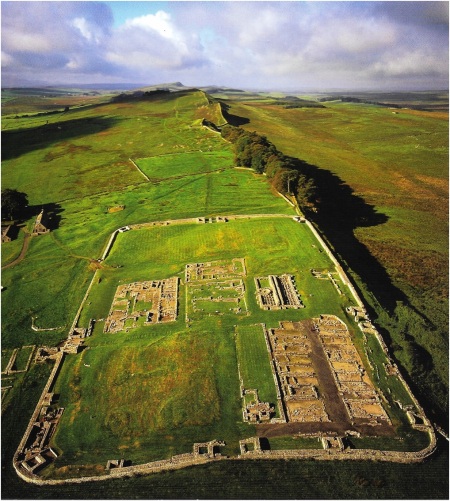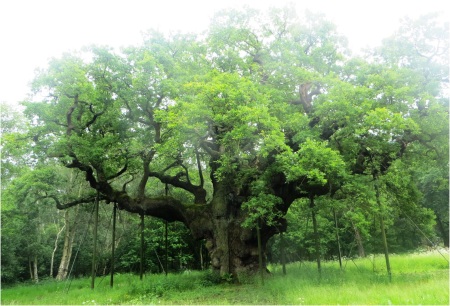
For our few days in the caravan at Whitley Bay we didn’t do a great deal that was different from our weekend there the previous year, this time we were entertaining family, but one thing that we did do was to visit Hadrian’s Wall.
Although a lot of people think that the Roman Emperor’s Wall marks the border between England and Scotland it never has and never will because it runs a conveniently short distance between Wallsend near the River Tyne in Newcastle and the Solway Firth in Cumbria. When it came down to military expediency the Romans didn’t concern themselves too much about geography. The wall is entirely within England and although it is close to Scotland in the west at its eastern end the wall is fully seventy miles south of the River Tweed.

Hadrian’s Wall was a defensive fortification in the Roman province of Britannia, begun in AD 122 in the reign of the emperor Hadrian and was the northern limit of the Roman Empire, immediately north of which were the lands of the northern Ancient Britons, people so frightening that even the Romans wouldn’t take them on.
It was a very pleasant day for our visit and the sun was shining but I guess this would have been quite a bleak place two thousand years ago. I imagine a legionnaire waiting for details of his posting and hoping to go Spain or France to the warm inviting beaches of the Mediterranean Sea and bit of sunshine would have been bitterly disappointed to discover that he was going to the bitter cold north of England to help build a massive stone wall.

At a length of almost seventy-five miles long it is the largest remaining construction anywhere in the old Roman world and it was started and finished in just about six years which is an impressive rate of progress compared to how long it takes to get anything built these days.
Seventy-five miles sounds like a lot of wall but by way of comparison the Great Wall of China is over thirteen-thousand miles long, Donald Trump’s Mexico wall is approximately two-thousand miles and even in England Offa’s Dyke running between England and Wales was one hundred and fifty miles long stretching from the River Mersey in the North to the River Severn in the South. The Maginot Line in France (a sort of underground wall) was nine hundred and fifty miles long but ultimately completely useless because the French didn’t get to finish it and in 1940 the German Panzer divisions simply went around it on their way to Paris.
The Romans were more clued up than the French it seems and the wall goes all the way from coast to coast. They didn’t leave a gap at one end that the Barbarians could conveniently use to get past.

Hadrian’s Wall was built almost completely of stone with a small castle every mile to act as a watchtower and a large garrison fort every five miles which was manned by a cohort of troops numbering as many as eight-hundred. A cohort is considered to be the equivalent of a modern battalion.
It is possible to visit quite a lot of these old fortress sites and each one claims to be the biggest and the best but we chose Housesteads (maybe called Vercovicium in Roman times, no one really knows) simply because it is owned by the National Trust and being National Trust members we get to go visit for free, well, not really free but you know what I mean.

I didn’t really know what to expect of the wall, when I was a boy I wondered why the Northern Barbarians didn’t just get some ladders and climb over it when no one was looking but here at Housesteads I got to appreciate the massive scale of the thing. The wall was built on a natural hard granite rock escarpment called Whin Sill which rises dramatically and vertically out of the ground. If this wasn’t enough, on the northern side the wall comprised a ditch, then the wall, a military road an earth rampart and then another ditch with adjoining mounds. No Welcome Mats and if anyone was going to get over this wall it was going to take a lot more than a ladder let me tell you!
Once its construction was finished, it is thought to have been covered in plaster and then whitewashed, its shining surface reflected the sunlight and was visible for miles around, an extravagant expression of Roman military might and the border of the Empire.

So we visited the small museum, watched a short video presentation and then wandered around the site and the excavations and then walked the short distance to Sycamore Gap which is a point in the escarpment where glaciers in the Ice Age carved a path through the rock. The place is significant because here grows a sycamore tree which is said to be the most photographed tree in England and was voted English Tree of the Year in 2016.
Oh, I just love the idea that a country that is England has a Tree of the Year competition. It is astonishing that with such busy lives and so many distractions people actually take time out to vote in a Tree of the Year poll. What next? A weed of the year perhaps.
There is more to this tree however. It is also referred to as the Robin Hood Tree, not because it has anything to do with Sherwood Forest and the Major Oak but because a scene from the movie ‘Robin Hood, Prince of Thieves’ was filmed there, the one where he first comes across the villain Guy of Gisborne.

The Major Oak in Sherwood Forest (above) was voted Tree of the Year in 2014. The latest Tree of the Year (2017) is the Gilwell Oak in Epping Forest which has connections with the Boy Scouts and the founder of the movement Robert Baden-Powell. He adopted the towering oak as a symbol for the growth of the scouting movement world-wide.
So, now we have been to Hadrian’s Wall in Northumberland, The Maginot Line in France, The Great Wall of China, back to England and Sherwood Forest in Nottinghamshire and Epping Forest in Essex and once we were through with our visit to Housesteads we returned to the caravan in Whitley Bay.

Click on an image to scroll through the pictures…




















